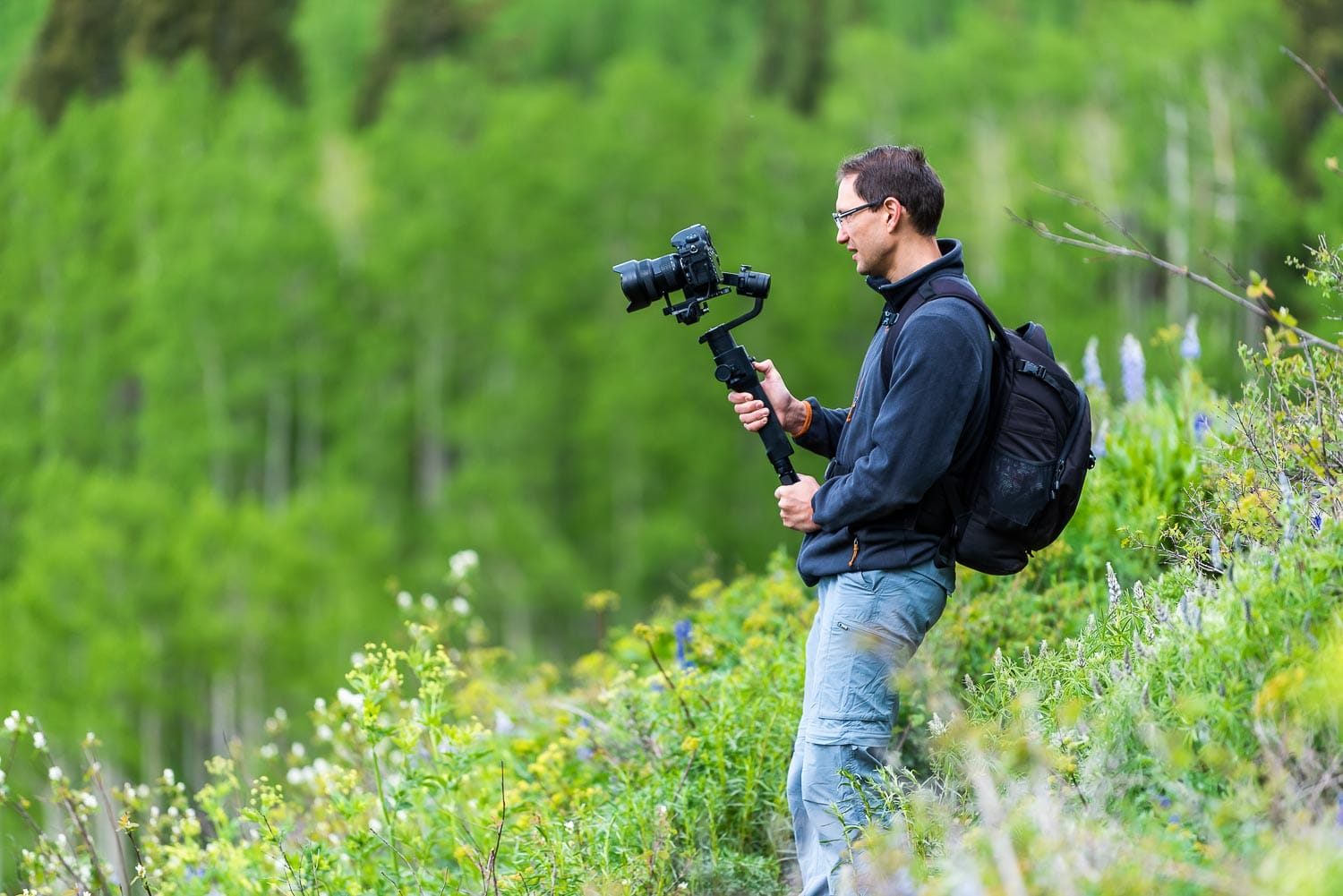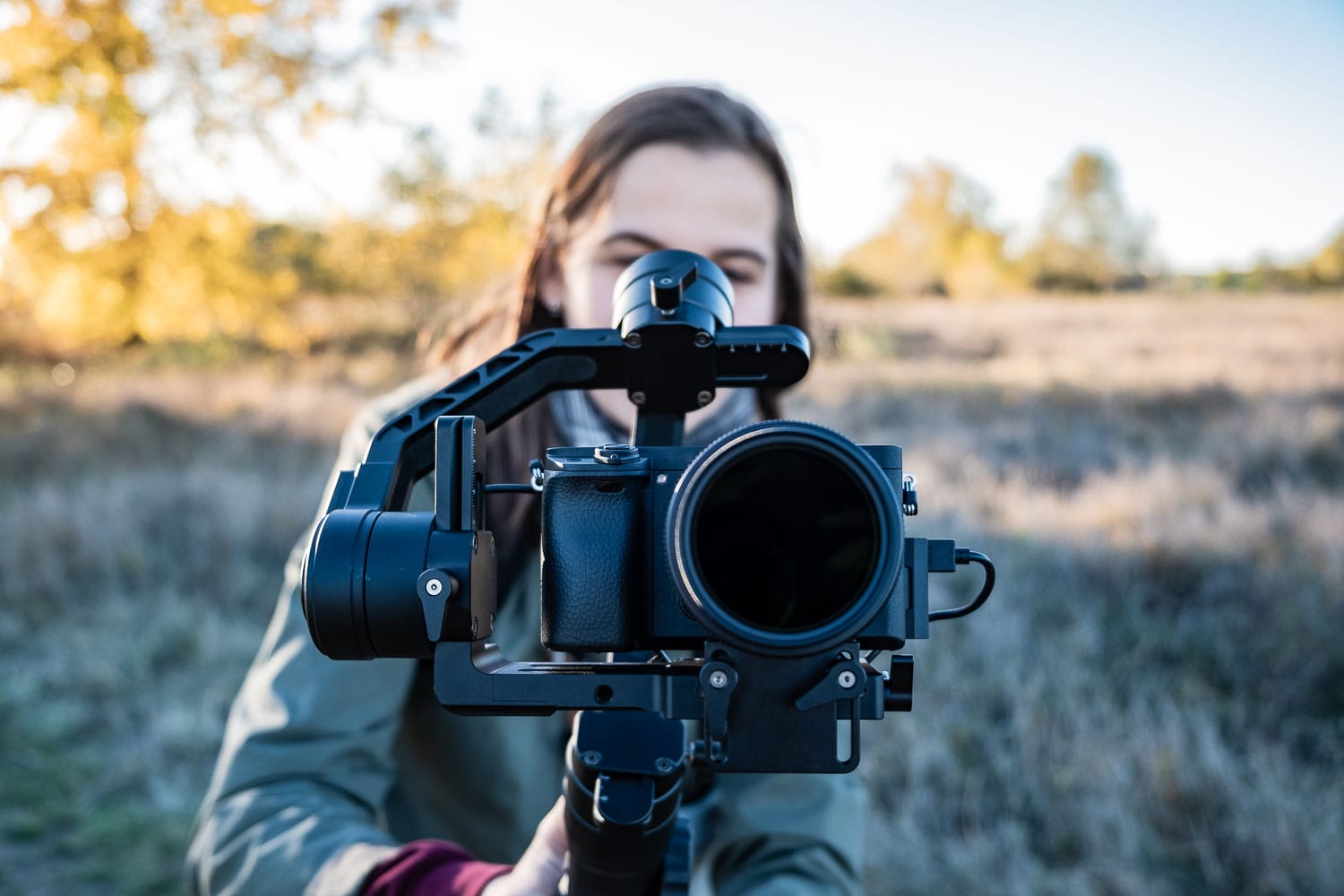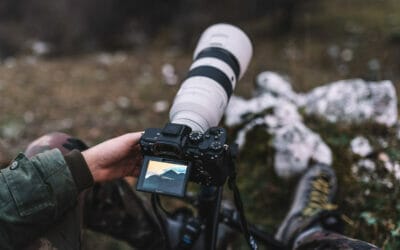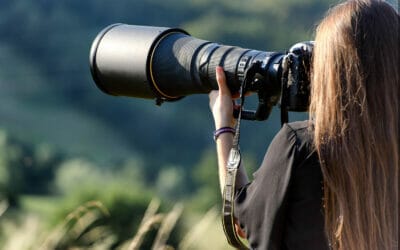Whether you’re a professional filmmaker needing cinematic shots or a novice searching for a reliable tool to get you started, selecting the right camera can be daunting.
We’re here to help.
In this article, we’ll delve into the best video cameras on the market for 2024, highlighting their features and what each is best suited for.
We’ll cover a range of options from high-end professional gear to budget-friendly options for those just getting going on their video journey.
And, because we all have different needs, budgets, and visions, we can’t choose just one best overall video camera, but we can – and will! – give you the info you need to find the best camera for you when shooting video!
Contents
- How we picked the best cameras for videography
- Canon EOS R5
- Canon EOS R7
- Nikon Z 9
- Fujifilm X-H2S
- Panasonic LUMIX S5 II
- Blackmagic Cinema Camera 6K
- Sony Alpha 7S III
- Sony ZV-E10
- DJI Mini 3
- DJI Osmo Pocket 3
- Features and settings to consider when choosing
- How to choose the best video and filmmaking camera for YOU
- Additional gear to consider for your filmmaking kit
How we picked the best cameras for video and filmmaking
We at Conservation Visual Storytellers Academy have extensive experience in nature and wildlife photography and filmmaking. Our writers and editors use the major camera systems available and draw on our years of experience in the field.
To choose the best recommendations for you, we combine personal experience, insights from fellow pros and industry experts, editorial and user reviews, and details from manufacturers. We carefully weigh the pros and cons of each camera and put only what we feel are the best options available into our recommendation guides.
We’ve curated a selection of video cameras to meet the needs of different goals and budgets. Factors we consider include sensor size, resolution, frame rate, and more to help you have the best experience creating videos. We also included a mix of entry-level and professional cameras from a variety of manufacturers.
For advice on what to consider in a camera for video and filmmaking and how to choose the right one for you, use the table of contents to jump to those sections.
Best Cameras for Video and Filmmaking: Our Reviews & Recommendations
Canon EOS R5
This camera has risen to the top of the ranks with 8K raw video recording and robust in-body image stabilization, making it ideal for professionals and enthusiast hobbyists.
- 8K DCI cinematic movie capture
- 1,053 point hybrid class leading autofocus system
- Robust 5-axis IBIS with up to 8 stops of shake correction
- Durable, weather-sealed body
- Overheating can limit recording time
- Body Type: Mirrorless
- Sensor: Full-frame CMOS (35.9 x 24 mm)
- Stills: 45MP
- Video: 8K at 30fps, 4K at 120fps
- Weight: 1.6 lbs (with battery and memory card)
- Price Range: $$$
WHAT WE THINK
If you know us, you know we love this camera. From bird photography to landscape photography, the Canon EOS R5 is one of the most versatile machines on the market and with video, holy moly, does it not disappoint.
Its super fast DIGIC X processor allows the EOS R5 to record uncropped 8K videos at 30fps and 4K videos at 120fps. Its high-resolution sensor, swift and accurate class leading autofocus system, and impressive IS results in crisp, clear stills and movies.
Plus, the ISO range bolsters its performance under various lighting conditions and its full-frame sensor provides ample room for cropping without compromising on detail.
Our main concern here is the tendency to overheat, but, regardless, when it comes to producing incredibly high-quality shots, the Canon EOS R5 is one of our faves.
The Canon EOS R5 is a top-tier hybrid video and stills camera that excels with its 8K DCI cinematic movie capture, advanced autofocus system, and robust in-body image stabilization, making it ideal for professionals and enthusiast hobbyists despite its potential for overheating.
BEST PRICES
Canon EOS R7
An advanced, versatile mirrorless camera offering a range of frame rates and compression methods, superior subject detection and in-body image stabilization, all at a relatively lower price point.
- 651-point fast and accurate autofocus system
- Movie Servo AF includes subject detection and subject tracking
- Impressive 5-axis IBIS with with up to 7 stops of shake correction
- RAW burst mode with ½ second pre-shooting
- Durable, weather-sealed body
- No battery grip
SPECIFICATIONS
- Body Type: Mirrorless
- Sensor: APS-C CMOS
- Stills: 32.5MP
- Video: 4K at 30fps (electronic shutter)
- Weight: 1.3 lbs (with battery and memory card)
- Price Range: $$
WHAT WE THINK
As Canon’s most advanced APS-C, the versatile Canon EOS R7 mirrorless camera does an impressive job of capturing photos and recording video letting users switch between the two seamlessly.
With a variety frame rates and compression methods, the EOS R7 is able to shoot 4K using the full width of the camera’s sensor offering ultra high definition internal video and 10-bit sampling with Canon Log 3.
For wildlife photographers, Canon considers the EOS R7 the best for filming wildlife due to the narrow angle of view afforded by the APS-C sensor with the 4K 60p crop mode applying a 1.81x crop to the image.
And, even at its lower price, the EOS R7 brings with it Canon’s nearly unparalleled subject detection, autofocus, and in body image stabilization.
BEST PRICES
Nikon Z 9
A high-performance, versatile camera perfect for both stills and video recording up to 8K, boasting a full-frame sensor and a heat-dissipating body design, but its high price point and weight can be a concern for some users.
- Heat-dissipating body design allows 125 minutes in 8K/30p
- Class-leading autofocus scene detection system
- Essentially bottomless buffer depth
- Excellent low-light performance
- Durable, weather-sealed body
- Definitely a financial investment
- Relatively heavy
- Body Type: Mirrorless
- Sensor: 35.9 x 23.9 mm CMOS
- Stills: 45.7MP
- Video: 8K at 30fps, 4K at 120fps
- Weight: 2.95 lbs (with battery and memory card)
- Price Range: $$$$
WHAT WE THINK
For those looking for a Nikon, the Z9 is the ultimate in performance and versatility whether shooting stills or recording video as high as 8K.
The high-resolution full-frame sensor captures beautifully detailed and vibrant images while the speedy, accurate 493-point autofocus system and 5-axis in-body vibration reduction ensures you capture every moment clearly. 10-bit 4K UHD footage is recorded internally with full pixel readout at 24, 25, 30p as ProRes 422 HQ or H.265 video.
Although the high price can put it out of reach for some, the Z 9 is absolutely one of the best video cameras for those seeking top-notch performance and versatility.
A note: if you prefer a Nikon at a more affordable price, check out the Nikon D7500. With 4K video in ultra HD and 1080p full HD that includes stereo sound, class-leading ISO range, power aperture control, and fast image processing, you can’t go wrong with this DSLR camera.
BEST PRICES
Fujifilm X-H2S
A high-performance hybrid camera offering exceptional image and video quality, positioning it as a valuable investment for photographers venturing into videography.
- Stellar video quality and still quality
- 90 minutes of continuous recording at all resolutions
- 425 phase-detection point hybrid focusing system
- 5-axis IBIS provides up to seven stops of compensation
- Vari-angle LCD monitor can be fully rotated even with cables plugged in
- Durable, weather-sealed body
- Optional cooling fan not included, but available as an accessory
- Body Type: Mirrorless
- Sensor: APS-C X-Trans CMOS
- Stills: 26.16MP
- Video: 6.2K at 30fps
- Weight: 1.46 lbs (with battery and memory card)
- Price Range: $$
WHAT WE THINK
With an APS-C X-Trans CMOS stacked sensor that delivers true-to-life color, low noise, and just generally stellar image and video performance, the Fujifilm X-H2S is not just one of the best filmmaking cameras out there, but also one of the best hybrid cameras available.
This mirrorless camera tends to blow away still photographers and video shooters alike, especially when one dips their toe into the other field. They’re like, “Whoa, wait, what?! You’re good at that too?!”
The capability for 4:2:2 10-bit internal recording results in vibrant, lifelike footage in a range of resolutions, from full HD to DCI/UHD 4K, and in 6.2K at a 3:2 aspect ratio.
However, the lens mount can limit options and the autofocus, while good, isn’t as strong as, say, its Canon counterparts.
That being said, the Fujifilm X-H2S is a solid investment for photographers seeking a versatile hybrid camera.
BEST PRICES
Panasonic LUMIX S5 II
An excellent choice for any filmmaker or photographer, offering a blend of speed, precision, and high resolution, all at an incredibly reasonable price.
- Incredibly reasonable price for professional-grade camera
- Heat dispersion mechanism allows unlimited recording
- High resolution mode offers a 96MP equivalent
- Weather-sealed with a durable build
- While impressive, the 779-point hybrid autofocus is still working out a few kinks
- Body Type: Mirrorless
- Sensor: Full-frame CMOS
- Stills: 24.2MP
- Video: 6K at 30fps (electronic shutter), 4K at 60fps (cropped)
- Weight: 1.63 lbs
- Price Range: $$
WHAT WE THINK
This full-frame compact camera isn’t just the best option for dedicated hobbyists trying to stay within a reasonable budget, but quite possibly the best video camera on our list.
The Panasonic LUMIX S5 II is equipped with a 24.2MP 35mm full-frame sensor and a 14+ stop V-Log/V-Gamut capture to deliver impressive dynamic range and broad color.
Plus, the Real-Time LUT function offers in-camera color grading and its 5-axis in-body image stabilization system supports walking shots.
Hugely important is its heat dispersion mechanism that allows for unlimited recording – even in HD. Overall, the S5 II embodies a blend of speed, precision, and high resolution, making it an excellent choice for any filmmaker or photographer.
A quick note: While we absolutely adore the LUMIX S5 II, if you’re looking for an even more budget-friendly Panasonic, check out the LUMIX GH5M2. This mirrorless micro four thirds may not offer the breadth of filming of the S52, but it’s a couple hundred dollars cheaper and still provides impressive filming in a compact design.
BEST PRICES
Blackmagic Cinema Camera 6K
A compact, high-resolution camera with a wide dynamic range and dual native ISO, all housed in an ergonomic design.
- Fantastic high-resolution video quality
- Really reasonable price for a legit video camera
- Ergonomic design with multifunctional grip for handheld shooting
- A range of audio options
- Lacks in-body stabilization
- Body Type: Mirrorless
- Sensor: Full-frame CMOS
- Stills: 24.6MP
- Video: 6K at 36fps
- Weight: 2.65 lbs
- Price Range: $$
WHAT WE THINK
The full-frame Blackmagic Cinema Camera 6K captures rich colors with clarity in a range of formats and aspect ratios. With a wide dynamic range of 13 stops and a dual native ISO up to 25600, you can confidently capture clear, low-noise images in a variety of lighting conditions.
Plus, Blackmagic RAW preserves the quality of sensor data, ensuring detailed images and rich colors from the moment of capture to editing, color grading, and final mastering, while also archiving settings as metadata, allowing for in-camera adjustments or modifications during editing.
The Blackmagic Cinema Camera 6K is capable of shooting in HD up to 6K, while shooting stills at 24.6MP. The camera’s ergonomic design and compact form factor, featuring a multifunctional handgrip with all necessary controls for recording.
A large 5″ LCD, HDR touchscreen provides accurate focus and easy framing of shots and, while not included, the camera also supports an optional viewfinder.
BEST PRICES
Sony Alpha 7S III
An exceptional tool for filmmakers, delivering superior image quality and unprecedented performance in any lighting conditions.
- Optimized for 4K
- 15+stop dynamic range
- 16-bit RAW movie output up to 4K/60p via HDMI
- Internal heat dissipation allows 60 minutes of 4K/60p recording
- Fast and reliable autofocus
- Impressive performance no matter the lighting
- Lower resolution stills
- Body Type: Mirrorless
- Sensor: Full-frame CMOS
- Stills: 12.1MP
- Video: 4K at 120fps
- Weight: 1.54 lbs (with battery and memory card included)
- Price Range: $$$
WHAT WE THINK
With its full-frame BSI Exmor R CMOS sensor optimized for 4K, the Sony Alpha 7S III guarantees sensitivity, speed, and superior image quality.
The BIONZ XR processing engine, delivering 8x more processing power than previous models, supports wide dynamic range of 15+ stops, real-time AF tracking, recording up to 4K 120p, and a 16-bit RAW movie output up to 4K 60p via HDMI.
Fast readout capabilities ensure high frame rates, faster autofocus, and minimal rolling shutter, plus heat dissipation that allows for 60 minutes of 4K 60p recording help the Sony Alpha 7S III set a high standard in filmmaking.
A note: If you’re looking for a lower-priced option, there is the Sony Alpha ZV-E1. With a resolution of 4K 120p and the same sensor as the Sony A7S III, the Alpha ZV-E1 holds its own, especially when lighting is limited. While it doesn’t have a viewfinder, that’s not likely to bother all users.
BEST PRICES
Sony ZV-E10
An affordable, lightweight and user-friendly camera designed for filming videos, featuring a versatile E-mount system and advanced features.
- Set-up for simple live streaming
- Affordable compact camera
- Solid autofocus system with 7x adjustable transition speeds and 5x subject shift sensitivity
- 30 minutes continuous recording
- Includes a tally light
- No viewfinder
- Rolling shutter issues
- Body Type: Mirrorless
- Sensor: APS-C Exmor CMOS
- Stills: 24.2MP
- Video: 4K at 30fps
- Weight: 1.01 lbs
- Price Range: $
WHAT WE THINK
One of the best value options for filming videos is the Sony Alpha ZV-E10. This lightweight, compact camera with a small sensor compared to its Sony Alpha 7S III and Sony Alpha ZV-E1 counterparts, still results in an impressive final product.
And, with its wide lens selection and versatile E-mount system, it provides a wealth of creative possibilities.
Its fast BIONZ X processor ensures speedy image processing, while its ability to oversample 4K movies from 6K using full pixel readout and no pixel binning guarantees exceptional quality.
The camera’s Fast Hybrid AF, Real Time Eye-AF3, and Real-time AF tracking make capturing the action a breeze, the Background Defocus button provides an easy way to adjust depth of field, and image stabilization with active mode suppresses camera shake even while walking.
Its lightweight design and easy-to-handle body grip make it comfortable to carry, even for extended periods, making the Sony Alpha ZV-E10 a user-friendly, affordable camera that delivers phenomenal results.
BEST PRICES
DJI Mini 3
This beginner-friendly drone – offering stunning 4K footage, immersive colors, and advanced flight options – is an affordable ticket to capturing the world from a new perspective.
- Produces great shots
- 38 minutes of recording
- True vertical shooting
- Auto takeoff and return to home functions
- No internal storage
- Obstacle avoidance only available in Pro model
- Body Type: Drone
- Sensor: 1/1.3″ CMOS
- Stills: 12MP
- Video: 4K at 30fps
- Weight: 0.55 lbs
- Price Range: $
Looking to take drone footage, but new to the aerial world? The DJI Mini 3 is a great way to get started. Lightweight and compact, packed full of advanced features, and an impressive flight time of 38 minutes and a flight range of 10 km at a relatively reasonable price.
4k video and a still resolution of 12MP ensure crisp and clear shots, and the 1/1.3″ CMOS and dual native ISO result in true to life colors no matter the time of day.
And, while it only weighs about half a pound, it’s strong enough to stand up to winds of up to 38kph.
The well-thought-out gimbal design provides the camera with a large-angle tilt, opening up more shooting options. Auto takeoff simplifies the start of the flight and the return to home function ensures this lil gadget makes it back to you.
As a base model, it lacks obstacle avoidance, but the other features and the price make this one of the best ways to get started using a drone. But, if you want to go all out, check out the DJI Mavic 3 Pro.
While it’s nearly $2,000 more, the DJI Mavic 3 Pro triple-camera drone with a four-thirds CMOS sensor Hasselblad main camera, 43-minute flight time, and 15km HD video transmission is a recording beast in the sky!
BEST PRICES
DJI Osmo Pocket 3
A compact videography powerhouse that boasts superior optical performance, impressive low-light capabilities, and high-quality audio recording.
- Battery charges quickly and lasts
- Impressive low-light performance and overall image quality
- Full-pixel phase detection autofocus
- Compact and portable
- Mimo app has issues with some smartphones
- Body Type: Pocket gimbal
- Sensor: 1″ CMOS
- Stills: 9.4MP
- Video: 4K at 20fps
- Weight: 0.39 lbs
- Price Range: $
WHAT WE THINK
The DJI Osmo Pocket 3 is the ultimate portable video camera. Its fast-charging battery powers its compact design, while its 1″ CMOS sensor supports superior optical performance with clear highlight-shadow details and impressive low light performance.
In addition to shooting 4k, you can get 2.5 hours of recording if you bump it down to 1080p.
Fast full-pixel phase detection autofocus and 3-axis gimbal mechanical stabilization allowing clear imaging during dynamic movements and a 10-bit D-Log M color mode for recording up to one billion colors, delivering natural and delicate color gradations.
Audio performance doesn’t disappoint either with its built-in three-mic array that reduces wind noise and records omnidirectional stereo sound.
Despite facing some compatibility issues with the Mimo app, the compact and versatile DJI Osmo Pocket 3 is a powerhouse tool for high-quality videography on the move.
BEST PRICES
How to choose a camera for video or filmmaking: features and settings
When choosing a camera, understanding a few key criteria will help you choose the best one for you.
1. Sensor size
While the larger sensors of full-frame cameras typically provide superior image quality as they can capture more light, color information, and detail, but that doesn’t mean they’re the best option for every photographer and every situation.
Cameras with an APS-C and Micro Four Thirds sensor are often smaller, lighter, and less expensive with a crop factor allowing a narrower field of view, which can be advantageous for close-ups or when filming subjects from a distance.
2. Video resolution
From high definition 1080p all the way up to 8K, if you’re going to film video, you’re going to want good resolution. 1080p provides a decent level of detail for most uses, especially when viewing on smaller screens or at greater distances.
You may want a bit more detail though. 4K video quadruples the pixel count of 1080p, resulting in sharper images.
If you’re looking for an even higher resolution, check out cameras that offer 6K or even 8K. With four times the resolution of 4K and 16 times that of 1080p, the detail level in 8K footage is extraordinary, capturing even the smallest nuances in the scene.
Keep in mind that while higher resolutions provide more detail, they also demand more processing power to edit, larger memory cards to store, and more powerful computers to handle the larger file sizes.
3. Frame rate
When it comes to frame rate for a camera used for filmmaking 24 frames per second (fps) is generally sufficient for creating quality content for, say, online sharing, vlogging, or amateur filmmaking.
If you’re planning to do a lot of slow-motion footage, a camera that offers at least 60fps is recommended. In top-tier professional cameras, the rate can exceed 120fps.
4. Dynamic range
Dynamic range indicates the camera’s ability to capture the range of light intensities from the darkest blacks to the brightest whites.
Here are the key aspects to consider:
Stops of dynamic range: Cameras with a higher number of stops can capture more detail in the shadow and highlight areas of an image. For filmmaking, at least 12 stops is considered good and 14 stops or more is considered excellent.
RAW video capability: Cameras that offer RAW video capture provide greater flexibility in post-production, especially when it comes to recovering details from shadows and highlights. This can effectively increase the perceived dynamic range of the camera.
Log profiles: Many cameras offer log (logarithmic) profiles, which can help to preserve more dynamic range in your video footage. Log profiles capture a flatter image with more detail in the highlights and shadows. This gives you more latitude for color grading in post-production.
5. Other factors
Beyond the factors above, also consider the following:
Low light performance
When seeking a camera with strong low-light performance for filmmaking, look for a wide ISO range, noise performance that allows you to utilize a higher ISO, and a maximum aperture of f/1.8, f/1.4, or f/1.2.
Bit depth
A higher bit depth provides more color gradations, leading to greater color accuracy and a more realistic image. For example, an 8-bit image can represent 256 shades of each color (red, green, and blue), while a 10-bit image can represent 1024 shades of each color.
Image stabilization
Image stabilization can help reduce blur in low-light situations or when shooting handheld.
Autofocus performance
Reliable and quick autofocus is vital when capturing moving subjects. Look for a camera with an advanced autofocus system that accurately tracks and focuses on moving subjects.
Audio capabilities
Filmmaking isn’t just about the visuals. Consider a camera with a high-quality built-in microphone, or the ability to attach external ones.
Heat management
Filming in high-resolution or continuous shooting for long periods can generate substantial heat, resulting in automatic shutoffs or even damage to the camera’s components. To not be saddled by recording time limits due to overheating, look for a camera equipped with internal cooling mechanisms or one that’s designed to be well-ventilated or made with materials that dissipate heat effectively.
Lens compatibility
Interchangeable lens cameras allow you to swap lenses according to the specific requirements of your shoot. For instance, you might use a wide-angle lens for establishing shots, a standard lens for general-purpose filming, and a telephoto lens for capturing subjects from a distance.
Monitor
A camera’s monitor (or LCD screen) provides a larger and more detailed view of the scene, making it easier to frame your shots and review footage on location. Additionally, rotatable screens are useful for filming at unusual angles and touchscreen functionality allows a more intuitive control over settings and focus points.
Viewfinder
The viewfinder may not be the first determining factor when choosing a video camera, but it does play a role in certain scenarios. The viewfinder allows you to view your scene directly through the lens, providing an accurate representation of depth of field, focus, and framing. A viewfinder, particularly an electronic one (EVF), offers a clear view of your subject, free from glare and reflections that can impact LCD screens.
Photo: Kristi Blokhin/Shutterstock
How to choose the best video and filmmaking camera for YOU
Choosing the best camera for you involves a careful evaluation of your needs, preferences, and budget.
Determine what kind of films you’ll be shooting. For example, if you’re into adventure filmmaking, you may prioritize a camera’s durability, size, and weight.
On the other hand, if you’re producing cinematic content, you might prioritize high resolution, dynamic range, and low light performance.
A higher resolution, such as 4K or 8K, offers crisp details. A higher frame rate allows capturing slow-motion footage more effectively.
A wider dynamic range captures a larger spectrum of light intensities, and having RAW capability allows more flexibility in post-production.
Through all this, you’ll need keep in mind your budget.
The best video cameras come with a wide range of prices, from entry-level cameras to high-end professional gear. It’s essential to balance cost with your requirements.
Keep in mind the additional costs of necessary accessories like lenses, filters, batteries, memory cards, and possibly an external microphone, as these can add up.
Ultimately, the best camera for you is the one that meets your specific filmmaking needs while staying within your budget. Test a few models if possible before making the final decision.
Photo: Aleksey Boyko/Shutterstock
Additional gear to consider for your filmmaking kit
❂ Tripods and stabilizers
Investing in a sturdy tripod can be crucial for achieving steady shots and professional-looking footage, while a gimbal stabilizer enables smooth and stable movement, even while walking or running.
❂ Lighting equipment
Natural light can be unpredictable, and indoor lighting often falls short. Professional lighting equipment, such as softboxes or umbrella lights, can help control the light in your scene, improving the quality of the final footage.
❂ Microphones and sound equipment
While your camera may have built-in audio recording, a dedicated microphone can vastly improve the sound quality of your footage. Different types of microphones, including lavalier, shotgun, and condenser microphones, are suitable for different filming situations and needs.
❂ Editing software
Post-production is an integral part of filmmaking. Editing software allows you to cut and arrange your footage, add effects, and fine-tune color and sound.
❂ External hard drives
Filmmaking can generate large amounts of data, so ample storage is vital. External hard drives can store backups of your footage, ensure your computer’s performance isn’t slowed down by large files, and facilitate file sharing among your team.
❂ External recorder
An external recorder, such as a monitor/recorder or DVR, can unlock additional features and functions for your camera. They allow you to record footage in high-quality codecs, adjust color settings, and add filters or effects in real-time.
❂ Batteries and chargers
Keep multiple batteries and a charger handy to ensure your camera doesn’t run out of power during crucial shooting moments.
❂ Lens filters
Lens filters can protect your camera lens, reduce glare, enhance colors, and create special effects. There are various types of filters, including UV, Neutral Density (ND), and polarizing filters, each serving a unique purpose.
❂ Camera bag
A durable camera bag protects your valuable equipment and allows easy transportation of your gear to different shooting locations. Consider a bag with customizable compartments to accommodate various types of equipment.
























